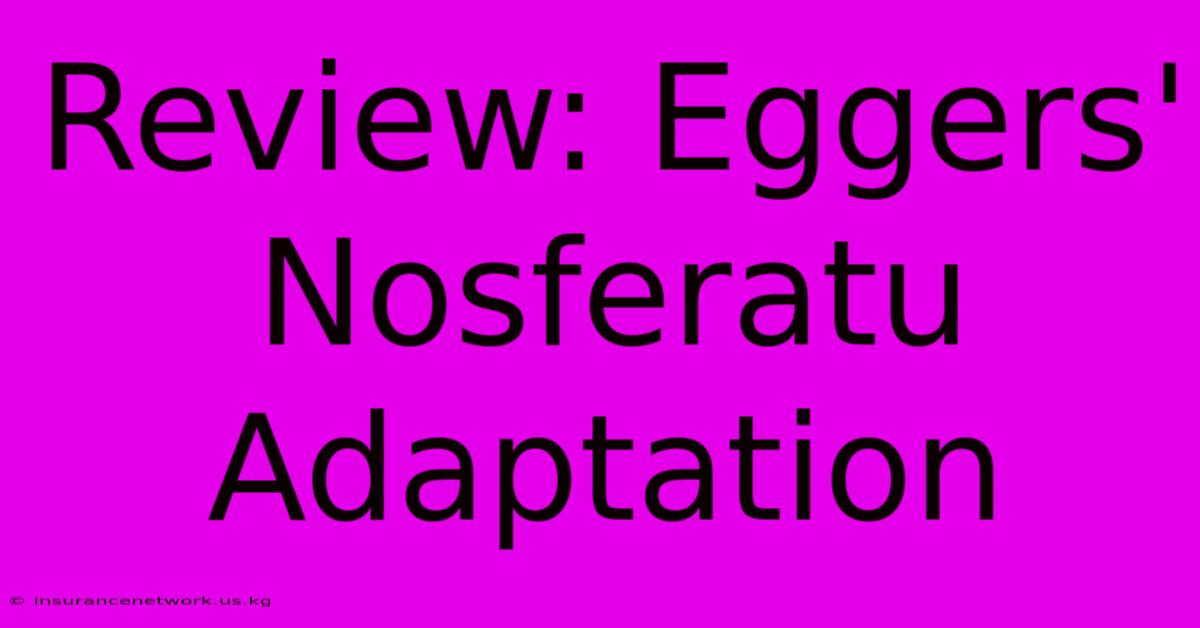Review: Eggers' Nosferatu Adaptation

Discover more detailed and exciting information on our website. Click the link below to start your adventure: Visit Best Website insurancenetwork.us.kg. Don't miss out!
Table of Contents
Review: Eggers' Nosferatu Adaptation – A Visually Stunning, Psychologically Chilling Masterpiece
Robert Eggers' highly anticipated adaptation of Nosferatu, while not a direct remake, offers a fresh and chilling interpretation of Bram Stoker's iconic vampire tale. This isn't your grandfather's Nosferatu; Eggers delivers a visually arresting and psychologically intense experience that stays true to the gothic horror of the source material while forging its own distinct path.
A Feast for the Eyes: The Visuals of Eggers' Nosferatu
From the opening scene, the film's visual language is breathtaking. Eggers meticulously crafts a world of gothic dread, utilizing stark contrasts of light and shadow, unsettling close-ups, and an overall aesthetic that evokes a sense of creeping unease. The cinematography is masterful, employing a deliberate pace that builds suspense and emphasizes the film's oppressive atmosphere. The costumes, set design, and makeup are all equally impressive, contributing to the film's immersive and unsettling world. The sheer artistry on display is undeniable, making this a visually stunning cinematic experience.
A New Take on an Old Monster: Count Orlok's Presence
While the Count Orlok character remains recognizable, Eggers' version is a fascinating reimagining. He's less a simple monster and more a force of nature, a creature of immense power and ancient evil. The performance capturing the essence of Orlok is incredibly effective, conveying both the character's chilling menace and a strange, almost unsettling vulnerability. This nuanced portrayal makes Orlok far more terrifying than a simple jump-scare villain. His presence lingers long after the credits roll.
Beyond the Surface: Exploring Themes of Isolation and Disease
Eggers' Nosferatu isn't just a monster movie; it's a deeply psychological exploration of themes of isolation, disease, and the corrupting influence of unchecked power. The film delves into the mental states of its characters, capturing their descent into paranoia and despair with unsettling precision. The film’s exploration of these thematic elements adds layers of depth, elevating it beyond a simple horror film.
A Slow Burn that Pays Off: Pacing and Tension
The film's pacing is deliberate and slow-burning, building tension gradually rather than relying on cheap jump scares. This measured approach allows the atmosphere to suffocate the viewer, creating a truly unsettling experience. While some viewers might find the pacing slow, it ultimately serves to heighten the impact of the film's most terrifying moments. The tension is palpable throughout, a testament to the film's skillful direction.
A Modern Gothic Masterpiece?
Eggers' Nosferatu is a film that demands to be seen. It's a visually stunning, psychologically unsettling, and thematically rich experience that pushes the boundaries of the gothic horror genre. While it deviates from the original story in some significant ways, it remains faithful to the spirit of the source material. This is not just a horror film; it's a work of art.
Ultimately, Eggers' Nosferatu is a triumphant achievement, a film that will stay with you long after the credits roll. It's a must-see for fans of gothic horror, arthouse cinema, and anyone who appreciates truly masterful filmmaking. This is a Nosferatu for a new generation, one that is both terrifying and unforgettable.
Keywords:
Nosferatu, Robert Eggers, Horror Movie Review, Gothic Horror, Vampire Movie, Film Review, Count Orlok, Arthouse Cinema, Cinematic Experience, Psychological Horror, Masterful Filmmaking, Visuals, Atmosphere, Tension, Suspense, Thematic Depth.

Thank you for visiting our website wich cover about Review: Eggers' Nosferatu Adaptation. We hope the information provided has been useful to you. Feel free to contact us if you have any questions or need further assistance. See you next time and dont miss to bookmark.
Featured Posts
-
Christmas Loss Doncic Leaves Game
Dec 26, 2024
-
Live Stream Boston Celtics Philadelphia 76ers
Dec 26, 2024
-
Lakers Davis Exits Game Injured
Dec 26, 2024
-
Boston Celtics Vs 76ers Tv And Online
Dec 26, 2024
-
Beyonce Sings Cowboy Carter Nfl Xmas
Dec 26, 2024
